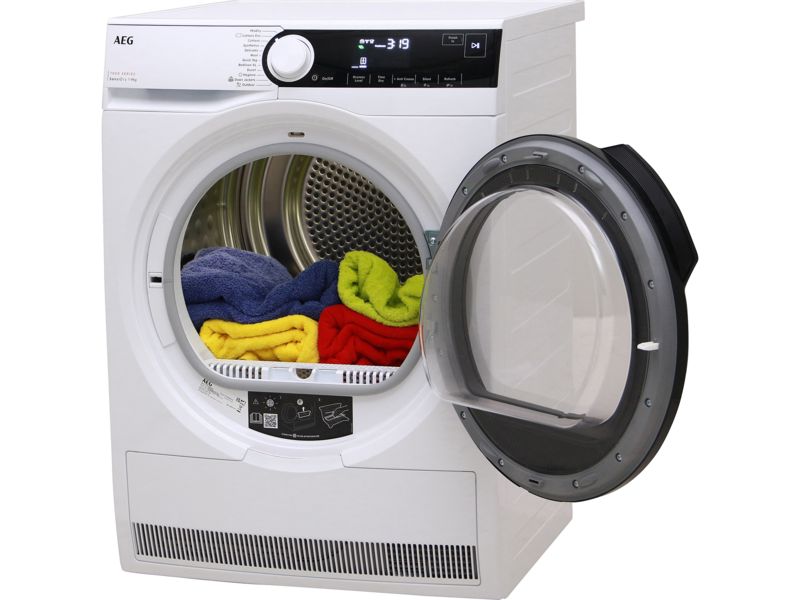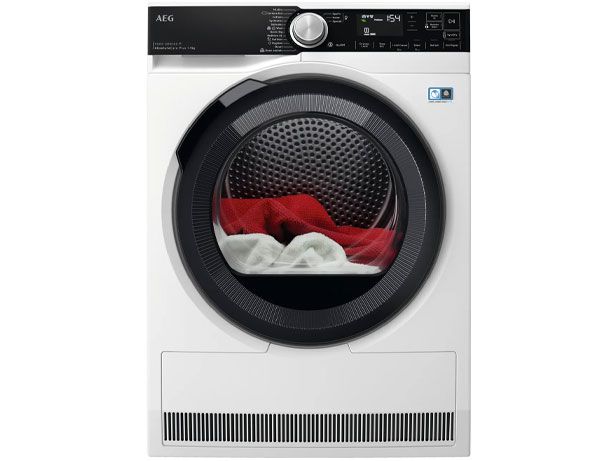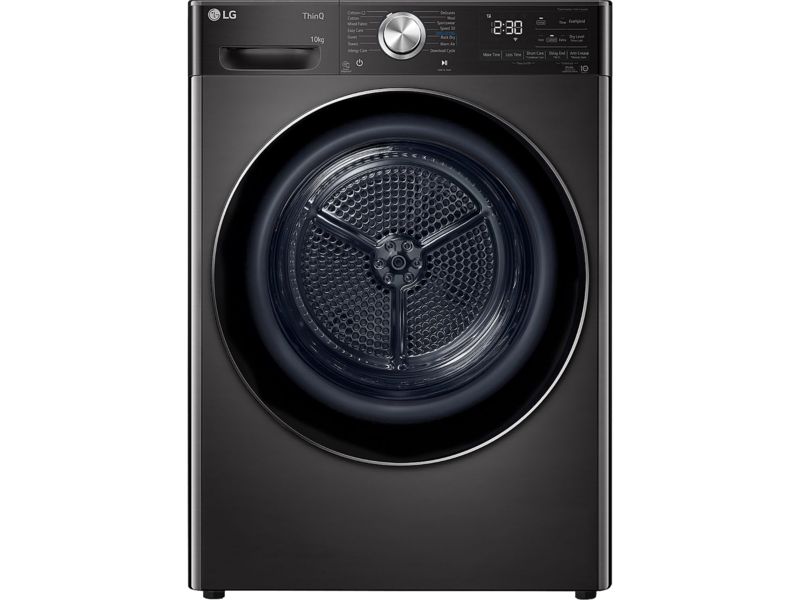How to buy the best integrated tumble dryer

In this article
- Best integrated tumble dryers
- Heading
- Why are there are so few integrated tumble dryers?
- Who makes integrated tumble dryers?
- How much do integrated tumble dryers cost?
- What is an integrated tumble dryer?
- What’s the difference between a vented, condenser or heat-pump integrated tumble dryer?
- What is the standard size of an integrated tumble dryer?
Integrated tumble dryers are few and far between. At the time of writing there are just a handful of integrated tumble dryers on sale in the UK.
But even with so little choice you could still end up buying a dud. This guide will tell you everything you need to know about integrated tumble dryers and will help you to find the best integrated tumble dryer for your home.
Looking for an integrated (built-in) tumble dryer right now? Head over to our integrated tumble dryer reviews.
Why are there are so few integrated tumble dryers?
Not as many people can or want to have an integrated tumble dryer which means that manufacturers make fewer models.
Who makes integrated tumble dryers?
- Baumatic
- Beko
- Candy
- Haier
- Hoover
How much do integrated tumble dryers cost?
Integrated appliances generally cost more than their freestanding equivalents with the most expensive costing around £800.
But you'll also find integrated tumble dryers for around £500.
What is an integrated tumble dryer?
Integrated tumble dryers are designed to be incorporated into built-in kitchens. They are installed within the units and typically sit behind a cupboard door. This keeps protruding features hidden from view, making the kitchen super streamlined.
You might have also heard the terms built-in, semi-integrated and fully integrated.
- Fully integrated/built-in – these are the most common. They sit within your kitchen units and are completely concealed by a door. A fully integrated tumble dryer has a flat front and should never be left freestanding as it won’t be stable enough.
- Semi-integrated – a semi-integrated tumble dryer will also sit within the unit and behind a door but the control panel at the top will still be on show. This enables you to easily change programs and check how long is left on the cycle.
What’s the difference between a vented, condenser or heat-pump integrated tumble dryer?

- Condenser tumble dyer – a condenser dryer collects the water from your clothes and transfers it to a container in the tumble dryer. You then have to empty the container once it's full. This is the most common type for integrated models because it can be placed anywhere in the home.
- Vented tumble dryer – if you’re opting for a freestanding model this will be the most common type. The water is removed via a hose that attaches to the back of the tumble dryer and transports the moisture outside. This means the tumble dryer needs to be placed close enough to an external wall or window for it to work.
- Heat pump tumble dryer – these dryers use the warm air that leaves the drum and moves through the condenser to dry the load; they are essentially condensers with a heat pump. Typically the most expensive type but also incredibly efficient. In fact, running costs for a heat pump dryer can be as much as halved when compared to other dryer types.
We review all three types. Jump to our tumble dryer reviews to compare how condenser, heat pump and vented dryers fared in our rigorous testing.
Or go straight to our condenser tumble dryer guide to see our top picks of the most popular type of tumble dryer.
What is the standard size of an integrated tumble dryer?
- Width: 60cm
- Height: 82-85cm
- Depth: 46.5-63cm (average 53cm)
Note: These measurements may not take into account protruding features or controls. Always check your product manual or ask the retailer for exact measurements before buying.
How to measure for an integrated tumble dryer
Always check the measurements before you buy a tumble dryer. The average depth of a tumble dryer is usually 46.5cm to 63 cm with an average depth of 53cm and there should be 70mm clearance at the back between the tumble dryer and the wall. The average tumble dryer height of 82cm to 85cm should fit under a standard counter top.

Integrated tumble dryer drum sizes: 6kg, 7kg, 8kg
It’s important to note that the dimensions of your tumble dryer don’t reflect the drum capacity. Just because it's big in size doesn't mean it can wash a large load of laundry, too. You should always check the drum capacity before buying to make sure it suits your laundry needs.
Integrated tumble dryers typically come with 6kg or 7kg drums, but can be as small as 3kg and as large as 10kg.
A tumble dryer with a 6kg drum capacity could dry up to 17 cotton shirts, while a 7kg drum could dry up to 21.
The average capacity measurements also differ depending on the program you’re using. For example, the estimates above are calculated using a cotton cycle, but the capacity on a synthetics cycle will typically be lower.
Want to know more about drum sizes? Read our best tumble dryers guide to find out how many shirts you'll be able to fit inside tumble dryers of varying sizes.
How to install an integrated tumble dryer
Fitting an integrated appliance is typically more complicated than installing a freestanding model. This is because you have to attach the cupboard in front and remove and replace the kitchen plinth.
The process will also differ depending on whether you have a vented or condenser model. A condenser model only needs to be plugged in before attaching the surrounding units, while a vented model would need a hole to be drilled in the back wall for the hose.
If you have a condenser model or you are just replacing an old vented machine, you could follow the instructions in your manual to fit the front unit and set the plinth.
However, if DIY is not your thing, we would recommend calling in a professional – warranties will not cover incorrect installation.

How much will it cost to install an integrated tumble dryer?
Professionals will charge more to install an integrated appliance than for a freestanding model because of the complexity of the job. Instead of just connecting the appliance they also have to fit the door and reattach the plinth.
Many retailers offer an installation service when you buy a new model. For example, Currys PC World charges £90 to install an integrated tumble dryer.
John Lewis also offers an installation service for £90 but states that it will only fit a vented model when there is an existing wall duct.
If you would rather call in a local tradesman to do the job, head over to Which? Trusted Traders to find a professional you can trust.
Are integrated tumble dryers better than freestanding?

Our research shows that the average scores for integrated and freestanding versions we’ve reviewed are on par. However, it’s important to note that there are far more freestanding models than integrated ones on our site, so comparing the two is not conclusive.
Problems also tend to arise for specific dryers rather than types. Check individual reviews before buying so you're not left with a dud.
How much will an integrated tumble dryer cost to run?
Vented tumble dryers are typically less energy efficient than other tumble dryer types. In fact, running costs can be as much as halved if you opt for a heat pump dryer.
Heat pump dryers are the most efficient of all. They are rated from A to A+++ for energy and cost on average £51 a year to run.
Heat-pump dryers are the most efficient, and will cost an average £59 to run a year; vented and condenser dryers will cost you an average £162 and £150 each year respectively.
The running cost is based on drying three cotton cupboard-dry loads a week, for a year.
If our testing reveals a machine that is a Best Buy with five stars for energy efficiency, it will receive an Eco Buy logo.
Find out how Which? tests tumble dryers to uncover the very best models.
Can I replace an integrated tumble dryer?

Yes, it's possible to replace an old integrated tumble dryer with a new one but you'd need to either find a new model with identical dimensions or rework your kitchen units.
You would also need to be extra careful when removing the door to ensure you can reuse it or you'll also find yourself searching for a second matching door.
Semi-integrated models would be even harder to replace. It would mean finding a new model with exactly the same-sized control panel – a feature that is not a standardised size or shape - as well as checking the dimensions.
Never try forcing a freestanding model into a kitchen unit either. Forcing a cupboard door on the front could cause damage that would not be covered by your warranty.


